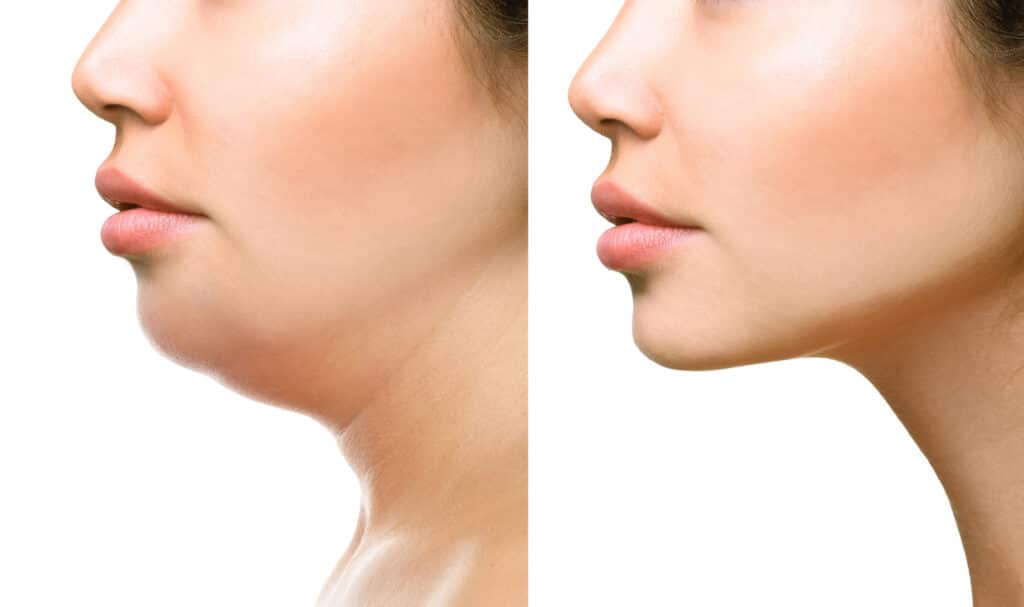Understanding Cryolipolysis
Fat Freezing
Cryolipolysis, often known as fat freezing, is a non-surgical method to reduce fat and target the fatty bulge, as opposed to invasive liposuction or other cosmetic surgery methods aimed at muscle toning. It uses cold temperatures to target and eliminate fat cells, unlike invasive liposuction or a tummy tuck, focusing on the fatty bulge without muscle toning. This process does not harm the surrounding tissues.
It works by cooling fat cells to a temperature where they can no longer survive. These cells, targeted by fat removal procedures such as injections for unwanted fat, then die and are naturally processed out of the body through fat removal treatments. The result of invasive liposuction, a fat removal procedure, is a more sculpted area where the treatment was performed, effectively reducing fat bulges.
Scientific Basis
The science behind cryolipolysis is both fascinating and effective. It leverages the fact that fat cells, unlike those targeted by invasive liposuction or injections, are more vulnerable to cold than other types of cells in the body, without the need for invasive procedures. This means cryolipolysis, unlike liposuction, injections, or other invasive procedures, can specifically target fat without damaging skin, muscle, or nerve tissue.
This selective targeting in liposuction, crucial for its success and safety, focuses on fat removal from fat bulges without invasive procedures. The treated fat cells are gradually broken down by the body’s immune system and removed through the liver, mimicking natural fat loss processes.
Global Acceptance
Cryolipolysis has gained global popularity as a preferred method for nonsurgical fat reduction. Its effectiveness and safety have been confirmed in numerous studies across different populations.
Patients appreciate its minimal downtime and lack of invasive procedures for fat removal compared to traditional liposuction. As such, it’s become a go-to option for those looking to reduce stubborn fat pockets without surgery, unlike liposuction.
Ideal Candidates for Non-Invasive Fat Removal
Stubborn Fat
Ideal candidates for non-invasive fat removal treatments, specifically Cryolipolysis, often struggle with stubborn fat deposits, unlike those considering liposuction. Despite regular exercise and a healthy diet, these individuals cannot seem to shed fat bulges in certain areas.
Cryolipolysis targets these resistant fat cells effectively. However, it’s crucial to understand that this method is not a weight loss solution but a fat removal technique. It’s designed for those close to their ideal body weight who want to eliminate localized fat.
Health Conditions
Not everyone is a suitable candidate for Cryolipolysis. Individuals with certain cold-related health conditions, such as cryoglobulinemia, should avoid this treatment.
The procedure involves cooling fat cells to a temperature that causes them to die without harming surrounding tissues. But for people with sensitivities to cold, this could trigger adverse reactions.
Realistic Expectations
Setting realistic expectations is vital when considering any fat reduction treatments. Those with loose skin might not see the optimal results from Cryolipolysis since the procedure doesn’t tighten skin.
It’s designed to reduce fatty bulges, not address skin laxity issues. Consulting with a qualified plastic surgeon can help set achievable goals based on individual body types and conditions.
Cryolipolysis Procedure Explained
Initial Consultation
The journey towards fat removal starts with an initial consultation. Here, a specialist assesses the client’s health and discusses goals. It’s crucial for aligning expectations and identifying the target areas for treatment.
During this stage, they ensure that the client understands the procedure fully. They explain that cryolipolysis is designed for fat reduction, not weight loss.
Treatment Session
Once deemed an ideal candidate, the client schedules their session. No anesthesia is required for this non-invasive procedure. The specialist applies a gel pad and applicator to the targeted area. This device cools fat cells to a temperature that causes their natural death while leaving surrounding tissues unharmed.
Clients often describe feeling a cold sensation followed by numbness in the treated area. Discomfort is minimal and temporary.
Post-Procedure Care
After the session, a post-treatment massage plays a pivotal role in enhancing results. It helps break down the frozen fat cells, making them easier for the body to eliminate naturally.
This massage also improves circulation to the treated area, aiding in quicker recovery and better outcomes.
Comparing Non-Invasive and Surgical Fat Reduction
Benefits Analysis
Cryolipolysis stands out for its minimal downtime and lower risk. Unlike surgical liposuction, it doesn’t require incisions or anesthesia. This means patients can often return to everyday activities immediately after treatment.
Surgical fat removal, on the other hand, involves invasive techniques that can lead to a longer recovery period. Patients might need weeks before they fully recover. The risk of complications is also higher with surgery.
Results Timeline
Non-invasive methods like Cryolipolysis show results over time. It can take a few months to see the full effects as the body naturally eliminates the treated fat cells.
Surgical options offer more immediate results. However, the healing process can mask these outcomes until swelling and bruising subside. This discrepancy in timelines is crucial for patients planning around specific events or seasons.
Cost-Effectiveness
Cryolipolysis is generally more cost-effective than traditional liposuction. The initial investment might be lower for non-invasive treatments due to the absence of surgical fees, anesthesia costs, and hospital stays.
The safety profile of Cryolipolysis adds to its value. By avoiding the risks associated with invasive procedures, patients potentially save on unforeseen medical expenses from complications.
Recovery and Side Effects of Cryolipolysis
Recovery Time
The recovery period for Cryolipolysis stands out due to its minimal nature. Most individuals can resume daily activities almost immediately after treatment. This contrasts sharply with surgical fat reduction methods discussed earlier, which often involve extended downtime.
Patients typically return to work or their usual routine right after a session. This convenience makes Cryolipolysis an attractive option for those with busy lifestyles.
Side Effects
Common side effects of Cryolipolysis include temporary redness, swelling, and numbness in the treated area. These symptoms are generally mild and resolve on their own within a few weeks.
Despite these side effects, many choose Cryolipolysis for its non-invasive nature and lack of significant discomfort post-treatment.
Complication Rate
Cryolipolysis boasts a remarkably low complication rate. Rare complications do occur but are infrequent compared to more invasive fat reduction procedures.
This safety profile reassures patients looking for effective fat loss without the risks associated with surgery. It underscores why Cryolipolysis is considered a safer alternative to traditional liposuction.
Effectiveness and Results of Cryolipolysis
Fat Reduction
Cryolipolysis, known for its cold technology, targets fat cells without harming the skin. Studies show an average fat reduction of 20-25 percent per session. Patients often see visible changes within three weeks. Yet, the most dramatic results appear after two months.
The body continues to flush out fat cells for up to six months post-treatment. This gradual process ensures natural-looking results.
Patient Satisfaction
Satisfaction rates are high among those who undergo cryolipolysis. They attribute their positive experience to minimal downtime and significant fat loss. However, outcomes vary based on individual factors like skin elasticity and lifestyle habits.
Multiple treatments can enhance results, especially in different body areas. Combining cryolipolysis with regular exercise improves overall outcomes.

Biological Process
After treatment, the body naturally processes the frozen fat cells and eliminates them. This biological response takes time, explaining why final results aren’t immediate but last long-term.
Patients report an improvement in their appearance and self-esteem as the treated areas become more contoured. The non-invasive nature of cryolipolysis makes it a preferred choice for many seeking fat reduction without surgery.
Limitations and Risks of Non-Invasive Liposuction
Immediate Results
Though non-invasive liposuction, particularly Cryolipolysis, has gained popularity, it has its limitations. One major constraint is its inability to provide immediate or dramatic weight loss results. Unlike invasive liposuction that can show significant changes shortly after the procedure, Cryolipolysis requires patience.
Patients might not see noticeable changes until several weeks post-treatment. This is because the body takes time to process and eliminate the destroyed fat cells. Also, multiple sessions, often spaced weeks apart, may be necessary to achieve desired outcomes.
Paradoxical Risk
A rare but concerning risk associated with Cryolipolysis is paradoxical adipose hyperplasia. This condition leads to an increase in fat volume in the treated area rather than a decrease. It’s more common in men and can be quite distressing for patients expecting a reduction in fat.
Although this side effect is uncommon, it highlights the importance of discussing potential risks with a qualified provider before undergoing treatment.
Provider Importance
Choosing a qualified provider cannot be overstated when considering non-invasive liposuction treatments like Cryolipolysis. The expertise and experience of the provider play a crucial role in minimizing risks such as discomfort, swelling, and the aforementioned paradoxical adipose hyperplasia.
Qualified professionals ensure proper treatment protocols are followed, including correctly setting up the machine for each minute session and monitoring patient responses during and after the procedure.
Final Remarks
Your journey through the world of non-invasive liposuction, specifically cryolipolysis, has armed you with essential knowledge. You’ve seen how cryolipolysis stands as a beacon for those seeking fat reduction without the scalpel’s edge. It’s clear that for the right candidates, this procedure offers a promising path to achieving aesthetic goals with minimal downtime. However, understanding its limitations and risks is crucial to setting realistic expectations.
Now that you’re equipped with insights into cryolipolysis’s effectiveness and potential side effects, the next step is yours to take. If you’re considering this procedure, consult with a qualified professional to discuss your specific needs and whether cryolipolysis is right for you. Remember, your journey to a confident self begins with informed choices. Let your newfound knowledge guide you towards making decisions that align with your health and beauty aspirations.
Frequently Asked Questions
Is non-invasive liposuction effective?
Yes, non-invasive liposuction, particularly Cryolipolysis, is effective in reducing fat in targeted areas. Results vary but significant fat reduction can be seen after a few sessions.
Who is an ideal candidate for non-invasive fat removal?
Ideal candidates are those close to their target weight with localized fat deposits that are resistant to diet and exercise. It’s not a solution for obesity.
How does the Cryolipolysis procedure work?
Cryolipolysis works by cooling fat cells to the point of death without harming surrounding tissues. The body then naturally eliminates these cells over time.
How does non-invasive liposuction compare to surgical options?
Non-invasive procedures like Cryolipolysis have fewer risks and no downtime compared to surgical options. However, surgical methods typically offer more immediate and dramatic results.
What are the recovery and side effects of Cryolipolysis?
Recovery is minimal with no required downtime. Common side effects include temporary redness, swelling, and numbness in the treated area.
What kind of results can I expect from Cryolipolysis?
Results can vary; however, most patients see a noticeable reduction in fat within 1-3 months post-treatment. Optimal results often require multiple sessions.
What are the limitations and risks of non-invasive liposuction?
While safer than surgical alternatives, it’s less effective for large areas of fat. Risks include temporary side effects like bruising or sensitivity in the treated area.










